MacBook Pro 16" With The M1 Pro Chip, Review
… The beast has been unleashed!
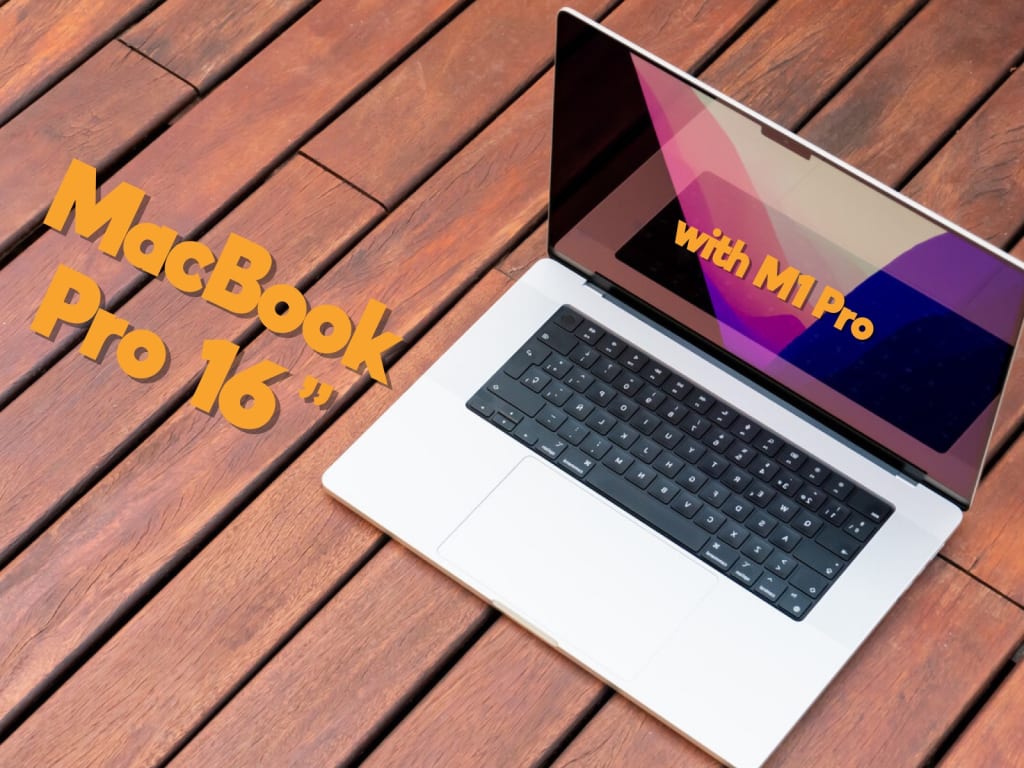
When I was watching the unleashed event one of the first things that came to my mind was Apple is going to knock out Intel with the M1 Pro presentation. But I was completely wrong. I thought I was right because a couple of weeks ago I was watching that awful Intel ad where they were mocking Apple.
Apparently, they thought that it was a good idea to release that advertisement to the world and that they were going to make look bad Apple but in fact, they were the ones that looked so bad. Even Marques Brownlee took the time to make a parody about it.
It was a very desperate move, indeed.
The hardest truth is that Apple doesn’t see Intel as competition anymore, I think they don’t see them as competition from a long time ago. And I was completely wrong because Apple is not going after Intel, they’re going after Nvidia, and I’m going to explain to you why.
Apple not just presented on that keynote the M1 Pro chip, but also the M1 Max chip. But, are those just pretty names, or what’s the real magic behind them?
Well, the first thing you need to know it’s that the M1 Pro and the M1 Max both have the same CPU and GPU as the M1 chips.
What’s new then? You may wonder. Let’s find out.
About the CPU
Before we begin the review I think it’s really important to know what we’re actually testing here. And since the real stars of the show are the chips, let’s talk really quick about what exactly are those, and then let’s see how they perform in the real world.
So… Apple developed a completely new SoC [System on a Chip] where they put the same CPU cores from the M1 chip but with new improvements. We used to have four energy efficiency at 1.8Ghz and four high performance at 3.06Ghz, and now we have 6 of high performance and only 2 of efficiency in the8 cores base model. And in the 10 CPU core configurations, we have 8 High-Performance Firestorms and 2 Energy Efficient Icestorms.
This means an improvement in speed as we now have faster cores.
Is that it? No.
The memory data bus is vastly improved. Let’s do a bit of contrast: On the A14 chip, Apple used a 64-bit data bus while on the M1 it increased it to 128-bit using 4,266Mhz LPDDR4X memory.
Now with the M1 Pro and M1 Max chips they use a more efficient type of memory: LPDDR5. This memory increases its clock speed to 4,266 Mhz. at 6,400 (6.4Ghz).
In addition, the communication channel in the memory of the M1 Pro increases from 128 bits that incorporated the M1 to 256 bits in the M1 Pro. Increasing the speed in the memory clock frequency, we went from 68.25GB/s peak transmission on the data bus to 200GB/s maximum.
And how does the M1 Max differ from the M1 Pro?
The M1 Max uses exactly the same 10-core CPU as the M1 Pro but increases the data bus to 512 bits in LPDDR5, this makes it double the speed, achieving peaks of up to 400GB / s in its communication. Therefore, having the same 10-core CPU in both the M1 Pro and M1 Max with the exact same speed, you will get more speed in an M1 Max than in an M1 Pro due to this significant increase in the speed of the communication bus of the memory.
Amazing, isn’t it?
About the GPU
I remember the time when I decided to switch from a Windows laptop to Mac, the main thing I missed was video games. At that time I was still a university student, and I spent hours playing Fifa with colleagues and the graphic power of my old laptop was brutal. Although the fan turned on to dissipate the generating heat to drain the graphics card, it never gave me any problems. I loved playing video games on my old laptop.
And that’s something Apple was never able to offer me … until now.
Apple added more cores of the same GPU as the M1 to the M1 Pro, with which we have a direct proportion of performance: 16 GPU cores reach 5.2 Teraflops in the M1 Pro and with 32 cores 10.4 Teraflops arrive. The base model M1 Pro’s 14-core GPU would stay at 4.55 Teraflops and the M1 Max’s mid-range model with 24 cores would come in at 7.8 Teraflops.
If we exclusively compare the power, this would mean that the 32-core M1 Max would be far superior to the graphics processor of a Playstation 5 and in a similar performance to an NVIDIA RTX 3080 in its range for laptops.
Without a doubt, this is Apple’s greatest success: getting the graphics power that the competition offers but with a power consumption of almost 100 watts less. This of course translates into heat generation far below normal industry standards to achieve such power.
We will talk about it below, with the tests we have carried out for the review, but I must say that getting the fan to turn on has been quite difficult.
By the way, comparing the M1 Max chip with a Playstation 5 beyond said empirical raw power data does not make any sense, because there are countless factors such as the architecture or the different components of the PS5 SoC, as well as its more graphic capabilities. beyond the power, they make us see that they are absolutely incomparable.
However, it is still a benchmark that tells us how far Apple has managed to go and how far it can go in the future with GPUs with more cores. Ok, but enough about theory… let’s go into the juicy part. Let’s see how these chips work in real life…
Introducing M1 Max MacBook Pro 16"
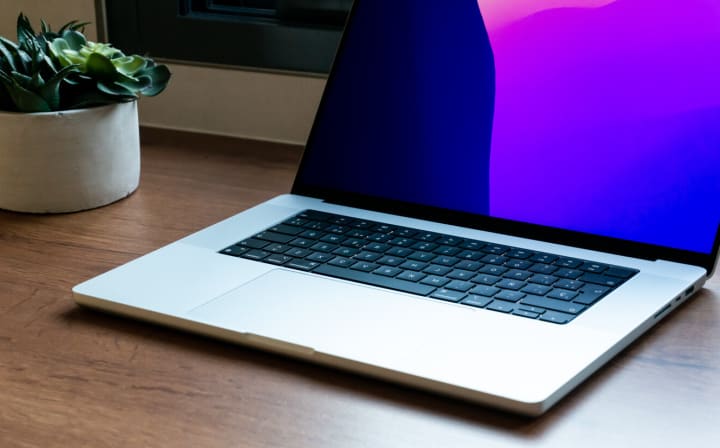
The new design of Apple’s laptops really comes as no surprise. It was expected practically from the launch of the first MacBooks with the M1 chip. Of course, Apple is a company that knows how to play in the big leagues and at that time Apple did not want any type of risk and presented the world with Apple's Silicon M1, the first chip 100% belonging to the Cupertino company. The goal was to focus on the speed and power of the new notebooks, and what the M1 technology was capable of offering, rather than aesthetics … and they succeeded.
With this new MacBook Pro, Apple aims to change the rules of the game. Even the company itself on its website qualifies these machines as “the first laptop of a new species.”
Apple with these laptops is sending a clear message to all its competitors, and that is that they are not going to step on the brake to be able to offer professional users everything they have been asking for for years.
Let’s start by talking about aesthetic design.
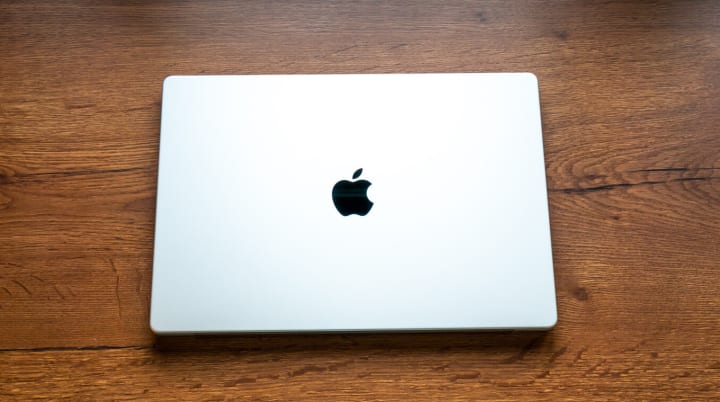
The new MacBook Pro is made from 100% recycled aluminum and is available in the traditional silver and space gray colors (in our case it is the silver model).
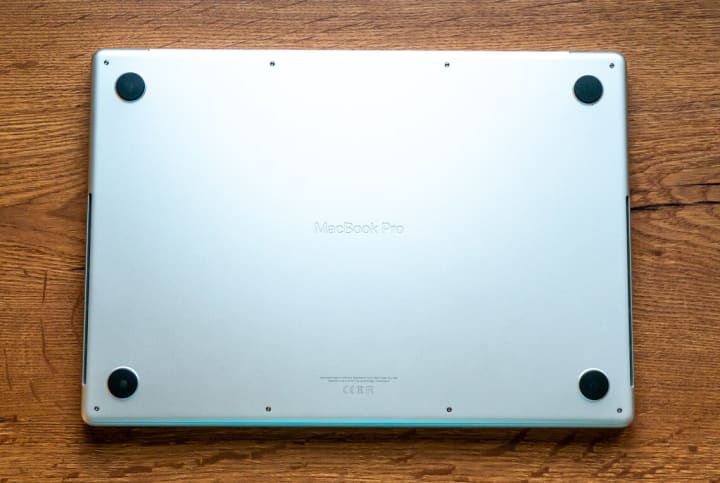
There are many, many things that have changed: one of the things that caught my attention the most is discovering that the keyboard is mounted on a dark surface. This part is designed to highlight the keys and above all, their backlighting if we use it in low light conditions. A true success, especially if you are a night owl and are used to working at night.
The keys use the same scissor mechanism as the next-generation Magic Keyboard. In dimensions and comfort of use, it is still a very good keyboard, comfortable to work long hours if necessary. The backlight is identical to previous generations. Remember that it can be regulated manually or automatically thanks to the sensors included in the new Mac.
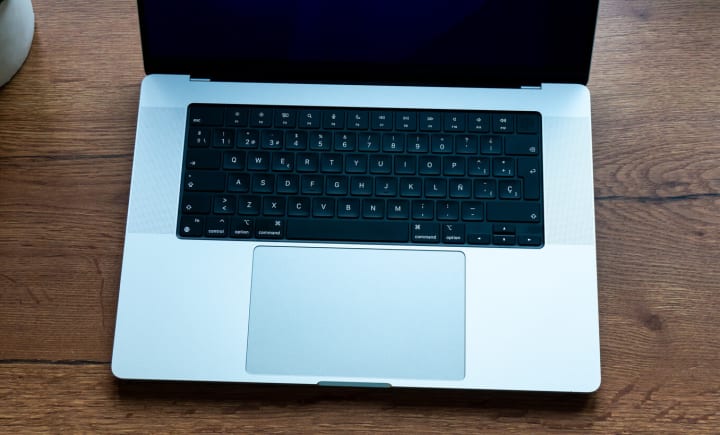
One of the most visible changes is the increase in thickness, going from 1.62 cm high in the MacBook Pro 16 “(2019) to 1.68 cm in this new model (also 16”). It’s funny because this small increase in thickness seems to be more noticeable in photos and videos than it really is in real life, so do not worry so much about this aspect. My recommendation is to look at it in-store in person.
Apple of course did not increase the thickness for its own sake.
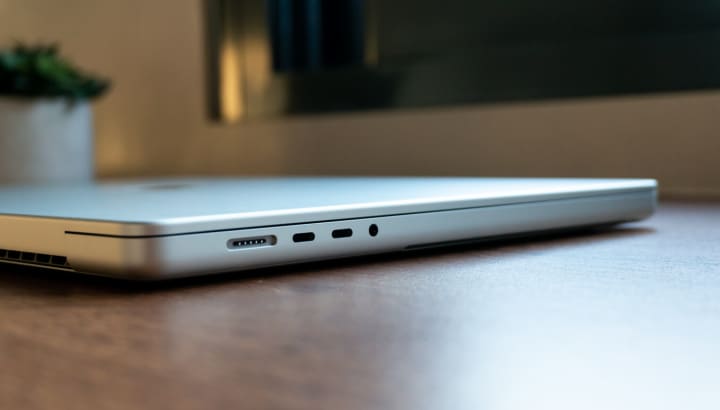
One of the decisions of this change is the improvement in ventilation. Now, in the lower left and right, we will find some air inlets that the ventilation system uses to recover cold air from the outside and expel it through the lower left and right area under the screen.
I am going to confess something that left me extremely surprised:
In each and every one of my tests, in absolutely all of them, I have not been able to get the fans to the maximum. I haven’t even been able to turn them on. And believe me, I have tried to force it with demos, video games, editing videos, or with any of the benchmarks but literally, this Mac seems to have no fans, as if it were my MacBook Air, but Pro.
One last thing, before moving on to the next section: Rest in peace the TouchBar. Its last appearance was on the MacBook Pro M1 released in November of last year. Of course, they keep the button with TouchID.
Liquid Retina XDR with Notch
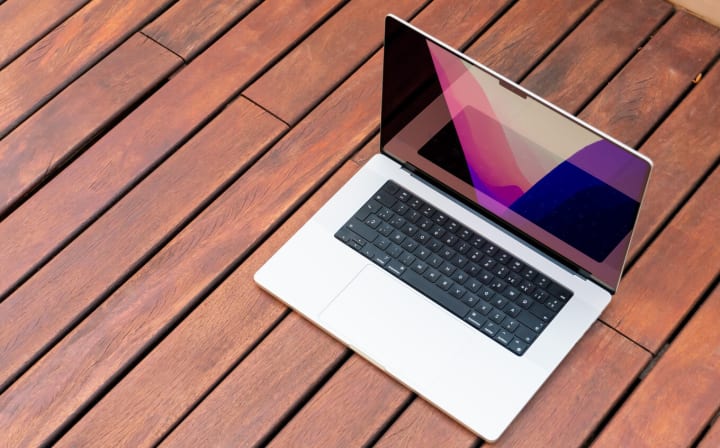
The new Liquid Retina XDR display is mounted on a mini LED panel capable of achieving an incredible 1,000,000: 1 contrast ratio and achieving purer blacks than ever in an Apple laptop.
It does this by illuminating groups of pixels independently across the screen, rather than having a uniform backlight from the rear.
To test the quality of the new panel, I used Apple TV + (testing video) and Lightroom (editing photos). The colors are vivid, strong and allow you to appreciate every nuance of the photo, even in gradients — smooth and continuous on-screen. There are night photographs where the contrast of car lights and traffic lights is spectacular on this screen, noting the difference between areas, colors, and contrast. We also have ProMotion on this screen, using the adaptive refresh rate ranging from 10Hz to 120Hz.
The improvement in the refresh rate is perhaps one of the characteristics that are most noticeable on a day-to-day basis. From using Mission Control to view windows, switch between desktops, or especially to surf the internet, the smoothness of scrolling and movement is now much smoother visually.
In video games, MacOS itself is the one who adjusts the frequency of the frames per second as in the iPhone 13 Pro Max. This means, for example, that if we are watching Apple TV +, the refresh rate will be balanced at the 24–30 fps at which this specific content moves to avoid using more battery than the account in something that the user would not perceive. Browsing in Chrome will go up to around 100 or 110 Hz.
Now let’s talk about the controversy: The notch.
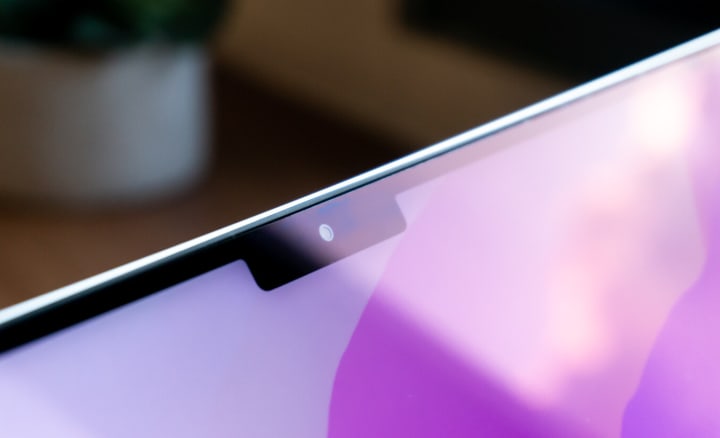
The design of these new MacBook Pros has balanced the upper and lower edges with the thickness of the sides, achieving a reduced bezel on all four sides of the screen that provides a feeling of novelty. The breadth is evident and frankly appreciated.
As in the iPhone, we now have a notch right in the center of the screen, where the new 1080p FaceTime HD camera is housed. This new camera has a four-element lens with a larger aperture (ƒ / 2.0), which allows better shooting in low light conditions. The image sensor has also been doubled compared to that of the previous generation, allowing the resolution to be doubled.
The truth is that with the use of video conferencing with this new camera, the images improve a lot, with clarity and details that are noticeable even in conditions with very low light — even contrasting the areas of light and shadow (something that is not usually seen in the webcams to use). The icing on the cake would have been that they had incorporated Center Stage, the tracking of the person through detection for video calls as it happens in the iPad Air or the new iPad mini.
If we look closely at the notch, we will only see the FaceTime HD camera lens and the usage led. By not using FaceID, we also do not have the TrueDepth sensor chain, which projects different types of LEDs to mathematically map the face. So what is in that notch of the MacBook Pro and why is it almost as large as the iPhone X?
Some people are of the opinion that the camera and the LED could have been camouflaged in the upper frame, thus avoiding the notch. But reducing it in size would not have been of much use, it would still be half as large in the middle of the bar. Apple has adapted macOS Monterey so that the menu bar is slightly larger on these MacBook Pros, and the notch can be “fitted” into it.
The good news is that the notch ends up “disappearing” from our workflow since the use is very natural as any of us use the Mac. By the way, it must be made clear that this notch is never seen in on-screen applications full, this is because the notch is outside the 16:10 ratio of the screen. When we put a movie, videogame on full screen, the strip on the sides of the notch turns black showing the upper and lower strips, and we can enjoy the content as always in that aspect ratio.
Is this notch the best solution on a MacBook Pro? Obviously not. We all would have liked some aligned edges without this area, also without really understanding what it does there and what problem it is solving. However, the “annoyance” of the notch in my experience of using several days goes to the background with daily use, where there comes a time when it simply “disappears” to focus on your workflow where this area does not disturb on any occasion.
The M1 Pro In The Real Life
I said it in the iPhone 13 Pro review, those iPhones are not for just any type of person. The same reflection carried over to the new MacBook Pros. They are not for everyone. The new M1 Pro and M1 Max chips have been enhanced with the professional workflow in mind with ProRes, one of the highest quality codecs in professional post-production.
This allows this M1 Pro processor laptop to display up to 4 8K videos in ProRes in real-time.
I have used Final Cut Pro with four of these 8 K and ProRes videos, and multiple effects capable … the MacBook played it without any problem, with the ability to go to any point of the video instantly without any delay, and with a fluidity that seems like an insult to my old Lenovo laptop.
In fact, it is also impressive that at this point, and by forcing this video in real-time to play cyclically, you do not even get the fans to be heard. What’s more, I couldn’t turn them on!
One thing guys, due to the extra decoders that come with the SoC of the M1 Pro and M1 Max, the benchmarks do not show all the real capacity that these processors are capable of producing.
However, let’s see how they look on the GeekBench 5:
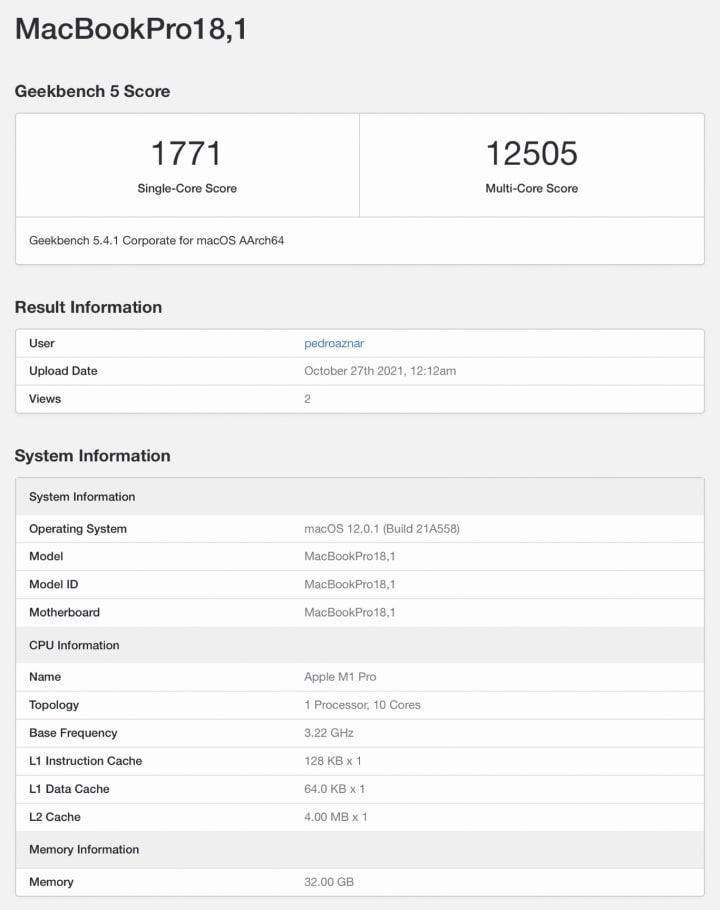
When we do the multicore calculation when the figure shoots up, since in this M1 Pro we have 10 CPU cores and 16 GPU cores:
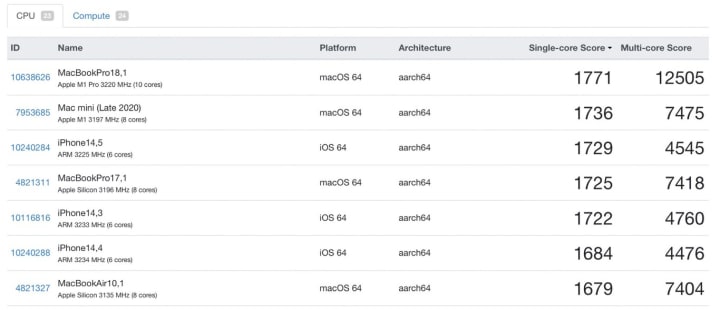
Let’s look at the case of Cinebench R23. Here the images are somewhat more contextualized that are used in their different types of measurements and obtaining results:
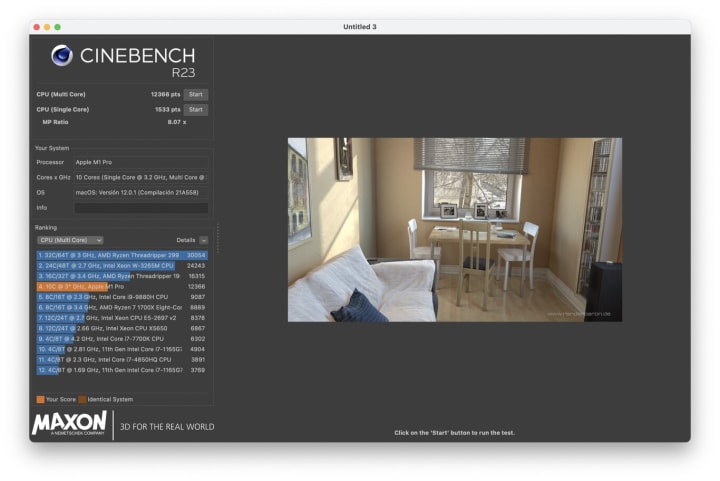
Then I went on to do a more realistic test, with a compression test that is often used to measure encoding speed in Final Cut Pro: the BruceX test.
The BruceX test is a project with a high resolution (5120x2700 at 24fps) and it measures the time in which we create the final file from the .fcpbundle. We got it on your website. I leave the link here in case you want to do the test yourself.
I took five samples and obtained the mean value, which gave us a result of 10.35 seconds to generate it, disabling the rendering in the second term to avoid the generation of buffer and forcing the complete calculation of the entire stream. To put you in context, I did these same tests last year and with the MacBook Air M1, it gave me about 21.12 seconds, and on the MacBook Pro M1, 18.46 seconds.
The last test I ran was the hard drive. I did the BlackMagic Disk Speed test to measure the speed of the new ultra-fast SSDs that can reach speeds of up to 7.4 Gb / s on the higher models. As you can see in the tests, 5.7Gb / s in writing and 5.2Gb / s in reading, an extremely good value, this means that it is perfect for handling large files with applications that make intensive use of them.
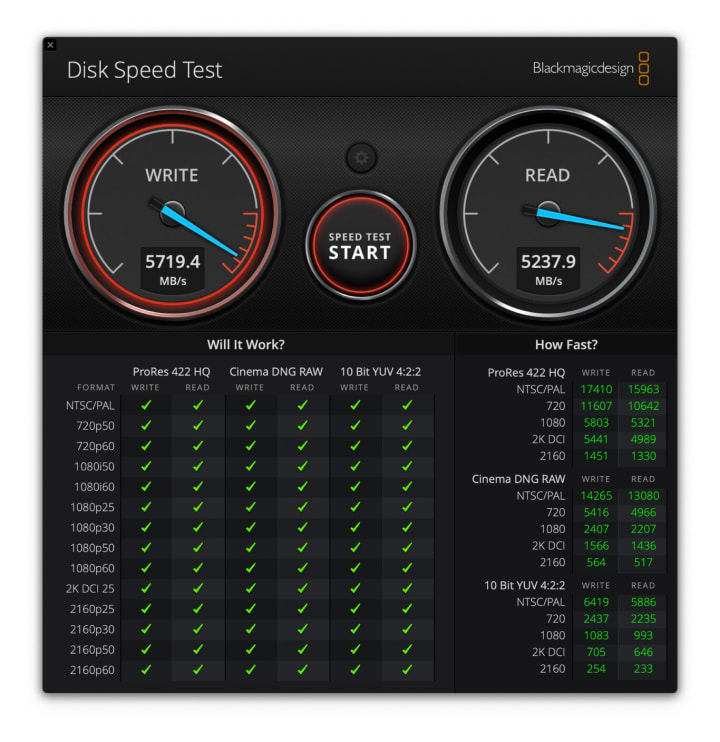
By the way, the battery life is pretty good. I turned on the MacBook at 9:30 in the morning and prevented it from going to sleep using Jiggler, an app that prevents the Mac from going to sleep by naturally moving the mouse continuously when I touch it. Then I played videos non-stop on Apple TV +. Also use Safari, Outlook, Notion, Spotify, Slack, Ulysses. I even played Little Orpheus, plus all the aforementioned tests … The screen brightness was at 50%. Remember that it has been used with the screen all the time. The battery ran out around 8:30 p.m.
One last thing: MagSafe is back… for the third time!
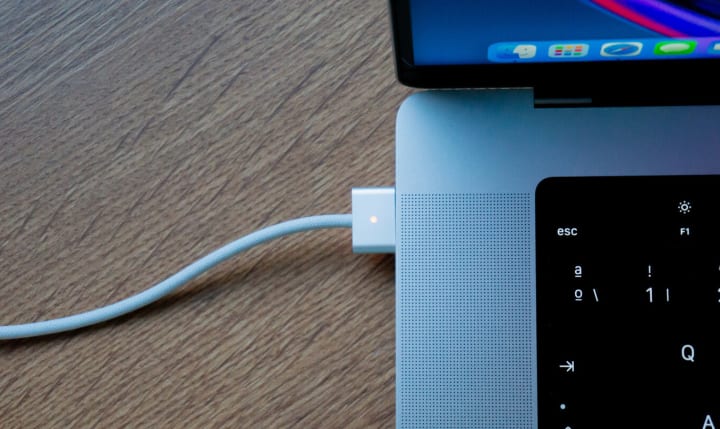
Apple is adept at taking things away and then putting them back in again a couple of years later and creating that sense of nostalgia. There is one thing that I must clarify and that is that when reincorporating products, it does so with a tremendous improvement. It has been redesigned to support much more load, and also to do it quickly It is a little smaller than the MagSafe 2, but it also has LEDs that indicate through the usual traffic light colors how the Mac is charging.
Conclusion
This MacBook Pro is a spectacular product in every way: designed from the inside out without leaving anything in between and with a power that is surprising in an industry where processors no longer attract so much attention. We can find the basic model from $2,499.00
(This review was previously published on Medium)
About the Creator
Juan Cienfuegos
Host of BitCorner 🎙️The 1st Salvadoran Bitcoin Podcast | Author of The Savior: #Bitcoin 🇸🇻⚡️ | engineer + educator






Comments
There are no comments for this story
Be the first to respond and start the conversation.